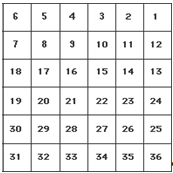I have seen some pretty fancy canes. Years ago, I had an Army buddy who collected walking sticks - everything from fancy canes with silver heads and ivory inlays to a staff that he insisted came from a Tibetan Lama. But my hand-carved cane is of another sort altogether. Mine is a limb cut from a grapefruit tree in my grandfather's back yard, with a handle carved and smoothed and with a rubber tip added to keep it from slipping. That's it below - if you look closely, you can see that nearly 60 years later it still has the bark on it.
My cane was a practical, if poor, man's solution to a need. Big Grandaddy made the cane so that Little Granddaddy could safely get around the house without falling. You see, like most folks, I had two granddaddys when I was a boy, but, unlike most folks, both of mine were on my mother's side of the family. My father's parents had both died before I was born, but on Mama's side, I was luckier - I had Little Granddaddy and Big Granddaddy.
Little Granddaddy stood about 5'6" tall and had not a spare ounce on his small frame. His name was Thomas Harmon Helms and he was born 30 October 1868, in Blue Springs, Barbour County, Alabama, and he was the father of Big Granddaddy, my grandfather. Big Grandaddy was Alto Lee Helms, and he stood nearly 6'5" tall - he clearly inherited his genes from his mother's Gunter family - she was nearly 6' tall, herself.
Little Granddaddy was the son of a Confederate Civil War veteran turned farmer and the grandson of a Primitive Baptist preacher. As a boy, he attended his grandfather's church and apparently the experience took, because Little Grandaddy spent his entire adult life as a Primitive Baptist preacher. He firmly believed that preaching was a calling and not a job. He preached on Sunday and sometimes on Wednesday nights, ministered to his congregation as needed, and worked hard all week earning his living as best he could.
 |
| Big Granddaddy and his father, Little Granddaddy |
Of course, I didn't know any of that back then; to me he was just Little Granddaddy. It wasn't until the last year of his life that I even figured out that the reason that Mama called him Granddaddy was because he
was her granddaddy.
What I remember him for are the days when Big Granddaddy would set the little table and a chair under the Chinaberry tree and Granny would bring out a glass and a big pitcher of iced tea and set them on the table. Little Granddaddy would sit in the chair drinking tea and watching me and my cousins play in the yard, occasionally admonishing us to stay out of the road - and every now and then sharing his tea with us. As we grew, he began to teach us. He showed us where the yellow-jacket nest was in the field next to the house and warned us to avoid it. And he taught us how to select the ripest guavas and tangerines off of the trees in Granny's back yard.
One my strongest memories involves the old cane and the one time in my life that Little Granddaddy ever yelled at me. It was a day when none of the cousins were there, just my sister and me - I was maybe 7 or so at the time. We were playing in the yard when sister violated the kid code in some way that earned her - in my totally unbiased opinion - physical retribution. She knew it, of course, even as she did it - so the chase was on. Off around the side of the house and up the front porch stairs. I was gaining, no more than 3 stair steps behind her, with arm raised to deliver the smack that she so richly deserved...for whatever it was that she did. She cleared the steps and darted for the front door and I knew that I would catch her when she stopped to open the door.
And at that moment, just as I cleared the steps, Little Granddaddy stepped between us from the side of the porch where he had been standing unseen. Looking down at me with those angry eyes and shaking that old cane above his head he bellowed at me "Boy, you don't
ever hit a girl!" Standing there with that raised cane, with his felt hat shoved back on his head and his white shirt almost glowiing in the bright morning sun, he rattled me so much that it might as well have been the voice of god rolling over me. I never forgot that moment.
Little Granddaddy lived until I was nine years old and to this day I have fond memories of him. Years later, when all of the cousins were grown, I told the story of the day that he yelled at me during a family reunion. Big Granddaddy apparently heard and remembered. When he died a few years later, the old cane came to me - 32 years later, I still have it.
And every now and then, I still tell my own grown sons Little Granddaddy stories because I want to help them understand that the man who raised them was once and forever deeply touched by a man born 142 years ago...and to maybe help them understand that history is only someone else's yesterday.
Thomas Harmon Helms, Little Granddaddy talking to me as I lie on his daybed on the closed portion of Big Granddaddy's front porch. I was about three - he was already over 80.



























